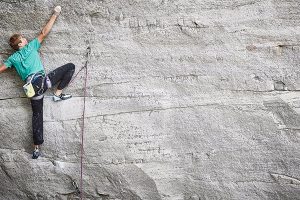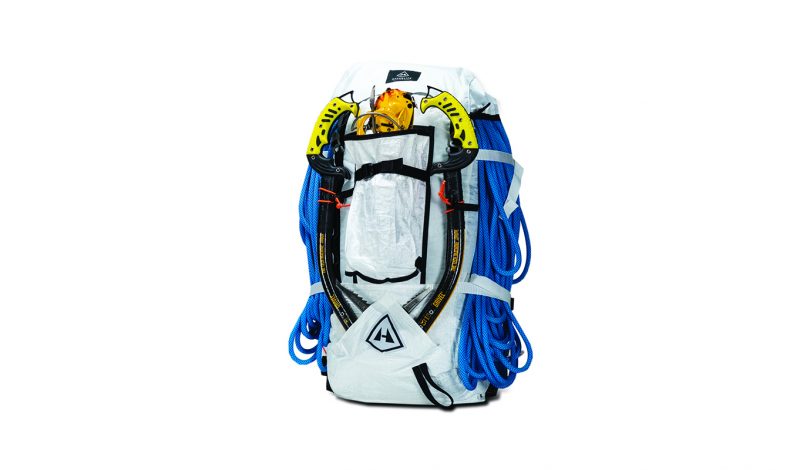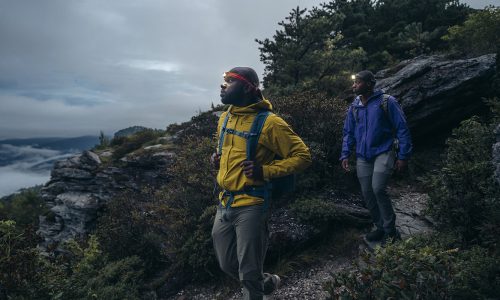Hyperlite Mountain Gear is well known domestic cottage industry producer of ultralight packs and shelters constructed with Dyneema Composite Fabrics. Their packs are historically spartan, often eschewing lids, side compression straps, or exterior pockets. But the Biddeford, Maine brand took a departure from their usual formula last month by releasing a more featured 40-liter alpine pack dubbed the Prism Pack. We took the Prism Pack to Banff, Canada for this First Look.
OK, so there’s DCF, but what else?
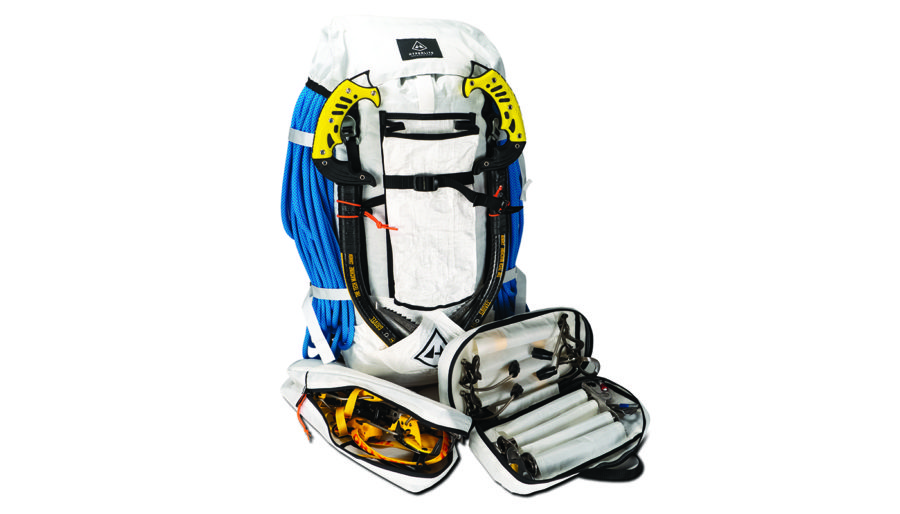 The Prism Pack looks at home in Hyperlite’s lineup, with the customary DCF white only colorway, but otherwise, the features mimic most minimalist alpine packs:
The Prism Pack looks at home in Hyperlite’s lineup, with the customary DCF white only colorway, but otherwise, the features mimic most minimalist alpine packs:
- Removable, Hardline with Dyneema hip belt with 1/8” closed cell rigid foam and 1/4” closed cell foam padding and spacer mesh features (2) gear loops, (2) ice clipper slots, and an offset buckle
- Extendable collar and removable 3.5 L floating lid with waterproof zipper and aluminum closure hooks
- Diamond-shaped pocket locks tool heads in place without buckles
- Reflective bungees with quick-release pull tabs secure ax handles
- External crampon pouch with easy-cinch closure
- Two compression straps on each side
- Top overload strap secures gear stored under the lid and applies vertical compression
- Two daisy chains on the front panel
- Axe loop for non-technical mountaineering axes
- Low profile side sleeve pockets with drainage holes
- Hardline with Dyneema shoulder strap construction with 3/8-inch closed cell foam, spacer mesh and load lifters with a metal hook attachment.
- Adjustable sternum strap with self-tensioning elastic and whistle
- Removable, contoured aluminum stay, and 1/4-inch foam back panel pad with a plastic stiffener
- Proprietary seam sealing on all side seams and behind all sewn-on pack features
- Bar-tacked reinforcements on all stress points
- Verified weight, size L: two pounds, four ounces
Like other Hyperlite Mountain Gear packs, the standout attribute is the Dyneema Composite Fabrics; most of the pack body is DCH150, while 375 denier DCHW protects side panels, bottom, and lumbar areas from abrasion. The high MSRP of $395 also sets it apart from alpine packs of similar volume from larger brands.
The Prism Pack is also offered in a Prism Alpine Climbing Kit with a matching crampon bag and ice screw case for $475.
Why DCF?
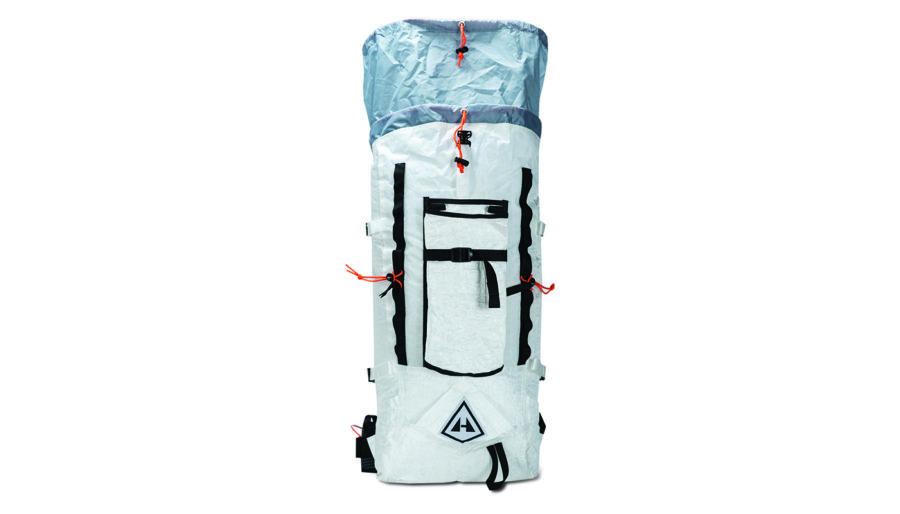 DCF’s main advantages are very low stretch, incredible tear strength, inherent waterproofness, and a low weight; all great characteristics for an alpine pack. DCF also has greater UV resistance than nylon. Despite all these advantages, the Prism Pack weighs five ounces less than my former go-to and less featured alpine pack, the Black Diamond Speed 40.
DCF’s main advantages are very low stretch, incredible tear strength, inherent waterproofness, and a low weight; all great characteristics for an alpine pack. DCF also has greater UV resistance than nylon. Despite all these advantages, the Prism Pack weighs five ounces less than my former go-to and less featured alpine pack, the Black Diamond Speed 40.
The huge disadvantage of DCF is low abrasion resistance, which Hyperlight combats with heavier deniers, especially on the bottom, sides, and lumbar areas of the Prism Pack. Even with these heftier fabric weights, the Prism still carries a weight advantage over my relatively durable alpine packs of equal volume.
First impressions from Banff
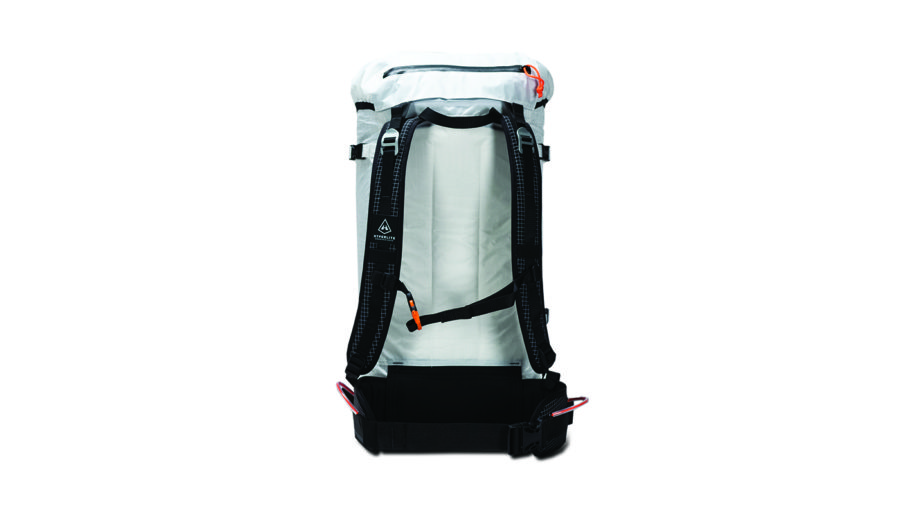 I used the Prism Pack on three one-day outings in Banff last week; only one outing requiring a 1000-foot gain to a dry tooling area provided use that I deemed as an appropriate warm-up for the Prism Pack, just enough for this First Impression. I carried ice climbing gear, two extra layers, snacks, and lunch; I added an extra few liters of water and puffy clothes to bring the load to just over 20 pounds and fill out the pack.
I used the Prism Pack on three one-day outings in Banff last week; only one outing requiring a 1000-foot gain to a dry tooling area provided use that I deemed as an appropriate warm-up for the Prism Pack, just enough for this First Impression. I carried ice climbing gear, two extra layers, snacks, and lunch; I added an extra few liters of water and puffy clothes to bring the load to just over 20 pounds and fill out the pack.
The Prism Pack loaded just like my other top-loading packs and required the same smart distribution of both mass and hardness to create a comfortable and efficient carry. The side and top compression straps cinched contents into a compact and stable package. I liked the simple way of stowing two ice tools; no buckles or bungees to secure the heads, break, or bumble with gloved hands. I felt the same about the aluminum hooks used to secure the lid to the daisy chains. The side pockets seemed perfectly suited for A-frame carriage of skis while the front-mounted pocket made for quick access and storage of crampons (useful when transferring on and off glaciers), jacket, or water bottle.
The pack carried much like my other minimalist alpine packs to no surprise. The single aluminum stay, plastic sheet, and closed-cell foam is a common suspension system for minimalist alpine packs and has comfortably carried 30+ pounds into the hills for me for decades, providing a great combination of load transfer, stability, and mobility. The padding in the shoulder straps, hip belt, and back panel was all the suitable density and thickness for the loads and clothing appropriate for alpine travel.
One curious feature that confused me initially was the offset hip belt buckle. I later realized how this would clean up the tie-in area when climbing with a harness. It is also notable that the only plastic buckle on the entire pack is the hip belt buckle.
I purposely threw the pack down on the sharpest rocks at the crag and dragged it across jagged edges several times while unpacking and packing; only the immediate and substantial soiling of the white fabric gave away any use. Although this isn’t close to being a test of durability, it did initially show that the heavier denier (compared to DCF tents) of the pack does offset the lack of abrasion resistance inherent to DCF. Lighter weight DCF used in my tents have been destroyed by less.
Conclusions
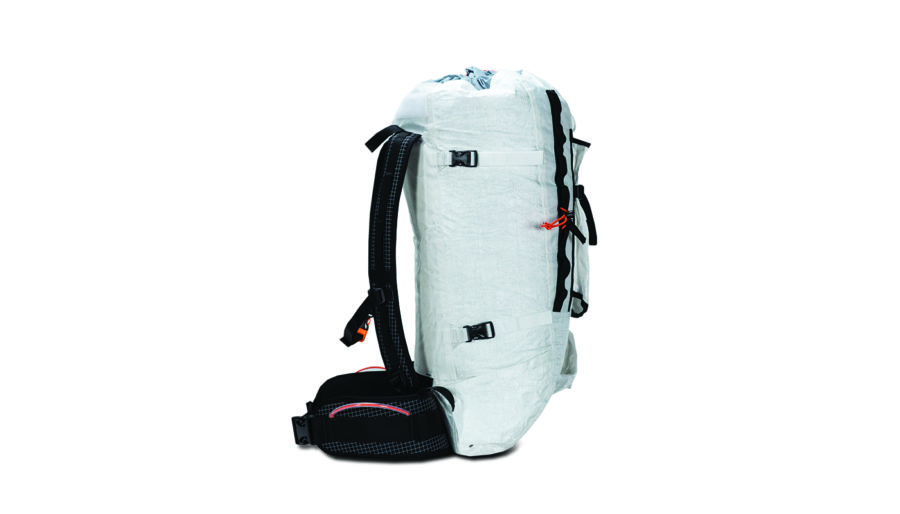 This First Impression revealed to me that the Hyperlite Mountain Gear Prism Pack carried like my other 40-liter minimalist alpine packs. The familiar suspension system performed as expected and proven over time. The feature set provides everything an alpine climber needs while leaving the fluff out to keep things lighter and simpler. If all this sounds like a generic description of a high end, minimalist alpine pack, that’s because it is; the Prism Pack’s kicker is the DCF.
This First Impression revealed to me that the Hyperlite Mountain Gear Prism Pack carried like my other 40-liter minimalist alpine packs. The familiar suspension system performed as expected and proven over time. The feature set provides everything an alpine climber needs while leaving the fluff out to keep things lighter and simpler. If all this sounds like a generic description of a high end, minimalist alpine pack, that’s because it is; the Prism Pack’s kicker is the DCF.
The DCF greatly enhances tear strength, minimizes stretch, and improves UV resistance, while being inherently waterproof. Hyperlite combats DCF’s lack of abrasion resistance with heavier weight fabrics, but the Prism Pack is still light for the capacity and features.
Does all the above justify the $395 price tag? The Black Diamond Speed 40 retails for $185.
My opinion is to reserve the Prism Pack for the discerning alpine climber that understands and appreciates the advantages and disadvantages of exotic materials and is willing to pay a premium for such. If the improved tear strength and UV resistance keep the pack in play exponentially longer, then the economics may make sense regardless (I have seen a Speed 40 packs destroyed in one season by an IFMGA guide).
Time will tell; look for a full review in the future after a few alpine trips are in the books. Buy now.

